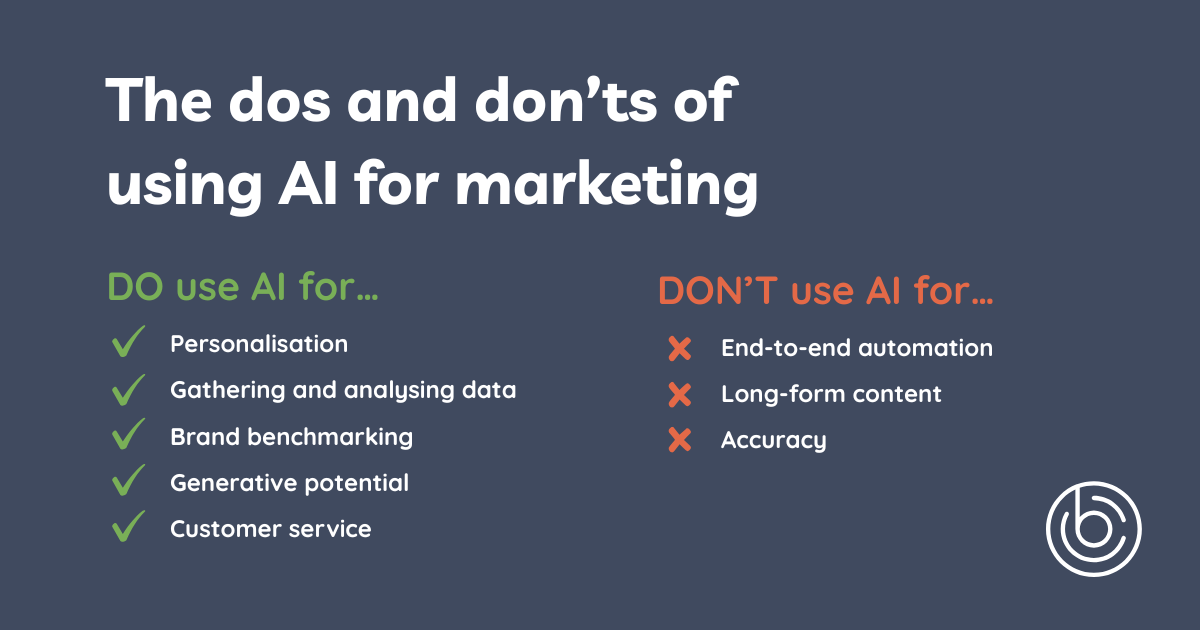Smart strategies without the artificial flavour
AI is quickly becoming an everyday part of the way the world is doing business. As marketers, it’s a fantastic tool to amplify our reach.
This is particularly true for small businesses in regional areas like the Riverina, Sunshine Coast and Northern Rivers because it’s the great leveller. You don’t have to be a huge company with vast resources to embrace the efficiencies that AI can bring. You just need about $20 a month!
But knowing when – and when not – to use AI for marketing can make all the difference. You want to be able to harness its advantages without damaging your brand reputation or losing customer loyalty. Because the human touch is still of vital importance, you can’t turn over everything to the AI – you still very much matter.
So when should you use AI for marketing – and when shouldn’t you?
DO use AI for…
Buyer/User Personalisation
People love tailored and personalised interactions, but we really dislike impersonal salesy marketing. So, we like the personal recommendations on our Netflix profiles… but we don’t like receiving generic emails that start with, ‘Dear customer,’ and then offer us something we’d be highly unlikely to ever buy.
AI gives us more opportunities to personalise our interactions with our clients and customers by giving us access to detailed consumer profiles and data. This information then allows us to predict future behaviour. When we know this, we can tailor our interactions and create a better overall consumer experience.
Starbucks’ AI-driven platform Deep Brew is a great example of this. It’s able to not only send tailored marketing messages but also offers personalised menu recommendations based on your tastes and other factors like the weather. An iced latte on a sizzling summer’s day? Yes, please!
It’s not only a better experience for the consumer. Starbucks has achieved record quarterly earnings and seen a substantial increase in active rewards program members.

Gathering and analysing data
AI is particularly skilled when it comes to examining huge amounts of information. While human employees would take a long time gathering, measuring and analysing the raw data, AI can complete this extremely efficiently.
This can greatly benefit the market segmentation process and help you gain a better understanding of your target market. This information can then be used to refine the marketing strategy and boost ROI. Regional businesses that operate predominantly online may find AI particularly helpful for understanding their remote customers better.
Procter & Gamble used AI well in marketing its Oral-B iO toothbrush – and in an entirely unique way. By using AI to gather raw data via 3D teeth tracking set into the toothbrush itself, they provide real-time feedback to customers to offer a more effective clean.
The toothbrush gathers the data, and the AI actively interprets it to identify areas of the mouth that might be missed, detect if pressure levels are good and helps the user to adjust how they’re brushing in the moment. This leads to better dental outcomes overall (and possibly a more enjoyable and supported dental routine!).
Brand benchmarking
In marketing, you need to know where your competitors are and how your brand compares. AI is great for competitor analysis because, as mentioned above, you can more easily access huge amounts of data.
Brands can then use AI to collect information from their competitors and gain important insights into their operations and customer base. They can then use this to inform their own marketing strategy.
This is a growing area. In fact, the global market for AI-powered market research is expected to reach $8.4 billion by the end of this year. And a study by MarketingProfs showed that if you use AI for market research, you’re 2.5 times more likely to outperform your competitors.
A great example of this is Coca-Cola. Coca-Cola uses AI driven competitor analysis to see when a competitor might be offering a promotion, and then match that pricing in their vending machines and other points of sale. This means they don’t lose customers to a cheaper alternative but also increase brand loyalty

Generative potential
AI is great at brainstorming new ideas or expanding on existing ones for your marketing campaigns. Be sure to give it very specific prompts so you can tailor the results to your unique brand. Say you have lots of different ideas and need them to work together in one campaign, then AI can provide structure. It will see patterns that you can’t. Generative AI is also great at filling in gaps in your marketing plan by fleshing out ideas.
AI is also great at generating creative content. Ferrero teamed up with an advertising agency and used AI to mine a database of colours and patterns. It then generated 7 million different labels to create special-edition jars of Nutella. The end result? Every single jar was sold within a month. Imagine how long it would have taken a real-life graphic designer to generate the same output.
Social media is another area where AI can help with content generation. It can help to create witty captions and short-form content. For example, you might ask it to write a caption for a cat café and it comes back with ‘Come for the coffee, stay because Mr. Whiskers stole your seat.’ Cute and probably fine just as is.
But AI might also suggest, ‘Our lattes are so good, you’ll cough up a hairball!’ Maybe not the brand vibe you want to go for. That’s why all AI-generated content must be reviewed and polished by a human before going out to your customers.
Customer service
AI customer service hasn’t always been very helpful. People haven’t really loved engaging with chatbots when they really just want to speak to a person. But chatbots are getting better, and as long as you have a human on hand to quickly help where the chatbot can’t, you’ll probably find they’re able to help with those easy queries.
AI customer service agents can also help in other ways. Nike Fit allows customers to scan their feet with their smartphone and receive their ideal shoe size and shoe recommendation without even leaving their home. Great customer service!
Exceptional customer service can be a great boost to your marketing strategy and convert leads to loyal, long-term customers.

DON’T use AI for…
Despite all these helpful AI-driven solutions, there are some things that AI simply isn’t ready to handle when it comes to your marketing.
End-to-end automation
AI for marketing is not yet a ‘set and forget’ technology – so end-to-end automation (that is AI taking on a task from start to finish with no human review or engagement) shouldn’t be undertaken yet.
In fact, if you do fail to have a human employee check in throughout the process, you could be putting your company at risk. Customers don’t want to hear the excuse that it’s AI’s fault. At the end of the day, if something goes wrong for your customer, that is your fault. And if you don’t manage this, you could be putting your brand’s reputation on the line.
There have been a few famous examples of automation ending badly for companies, much to the public’s amusement. You may have seen the viral videos of McDonald’s AI drive-thrus in 2024, where voice assistants added ridiculous amounts of nuggets and other unwanted items like bacon to ice-cream orders. Or maybe you heard about the DPD chatbot who swore during an online interaction and wrote a poem calling the company, ‘the worst delivery firm in the world’.
These are funny – and not hugely damaging – but when the Queensland Symphony Orchestra used an AI image that was distorted and bizarre, they faced serious backlash. The Media, Entertainment & Arts Alliance called it ‘inappropriate, unprofessional and disrespectful to audiences and the musicians of the QSO.’ And this wasn’t good for their brand at all.
Long-form content
You’ve probably read content that sounds like it was written by AI. Overly formal and unnatural, very wordy and more than a little boring. Even when the AI is given the prompt to use interesting or colloquial language… and it does… it simply doesn’t work in long form.
The patterns that AI uses are too repetitive. As humans we don’t recognise these patterns consciously BUT our brains do subconsciously. And it makes it hard for us to take in information.
Additionally, most audiences aren’t ready to accept content created by AI just yet. Of course, this may change in the future, but for now, they still want to know that the blog posts and e-newsletters came from a human.
In a world full of content saturation, audiences want something that piques their interest and entertains them – not an approximation of a corporate brochure. Stick to hiring humans to write (or at the very least review and edit) your blog posts, web copy, EDMs and marketing video scripts. Authenticity is still a treasured brand value.**
This was highlighted when Microsoft published an MSN article listing Ottawa Food Bank as a must-see tourist destination, along with other errors. Although a spokesperson said the computer-generated article wasn’t published by unsupervised AI, it certainly raised eyebrows.
One user said, ‘Microsoft is really hitting it out of the park with its AI-generated travel stories. If you visit Ottawa, it highly recommends the Ottawa Food Bank and provides a great tip for tourists: “Consider going into it on an empty stomach.”’ Oh dear….
Keep in mind that AI can be used to help generate ideas for content and fill any gaps. It’s great at that!

Accuracy
There have been many examples of AI misinterpreting facts – sometimes even making them up. The British Broadcasting Company (BBC) conducted research earlier this year into how four well-known AI assistants would answer questions about the news when using BBC articles as sources. More than half of the answers had significant issues, 19% introduced factual errors, and 13% of quotes were altered or not in the cited article.
Needless to say, do not rely on AI for accuracy. This is an important consideration when using AI for marketing, as audiences are unlikely to trust a brand that makes factual errors.
Using AI for marketing is great – but use it wisely!
AI can be a powerful ally in your marketing toolkit, especially for regional businesses wanting to compete on a bigger stage. With the right balance of AI efficiency and human creativity, you can save time, spark ideas, and strengthen customer connections without risking your brand’s reputation.

